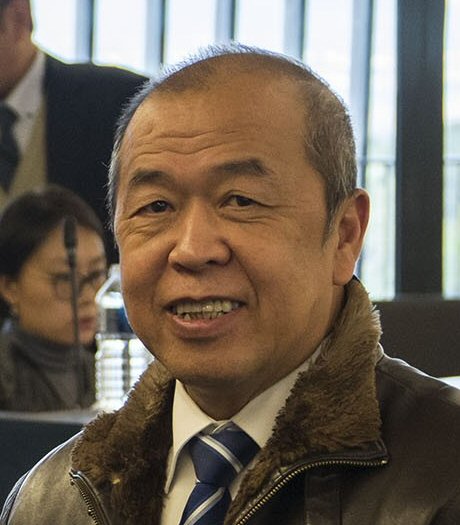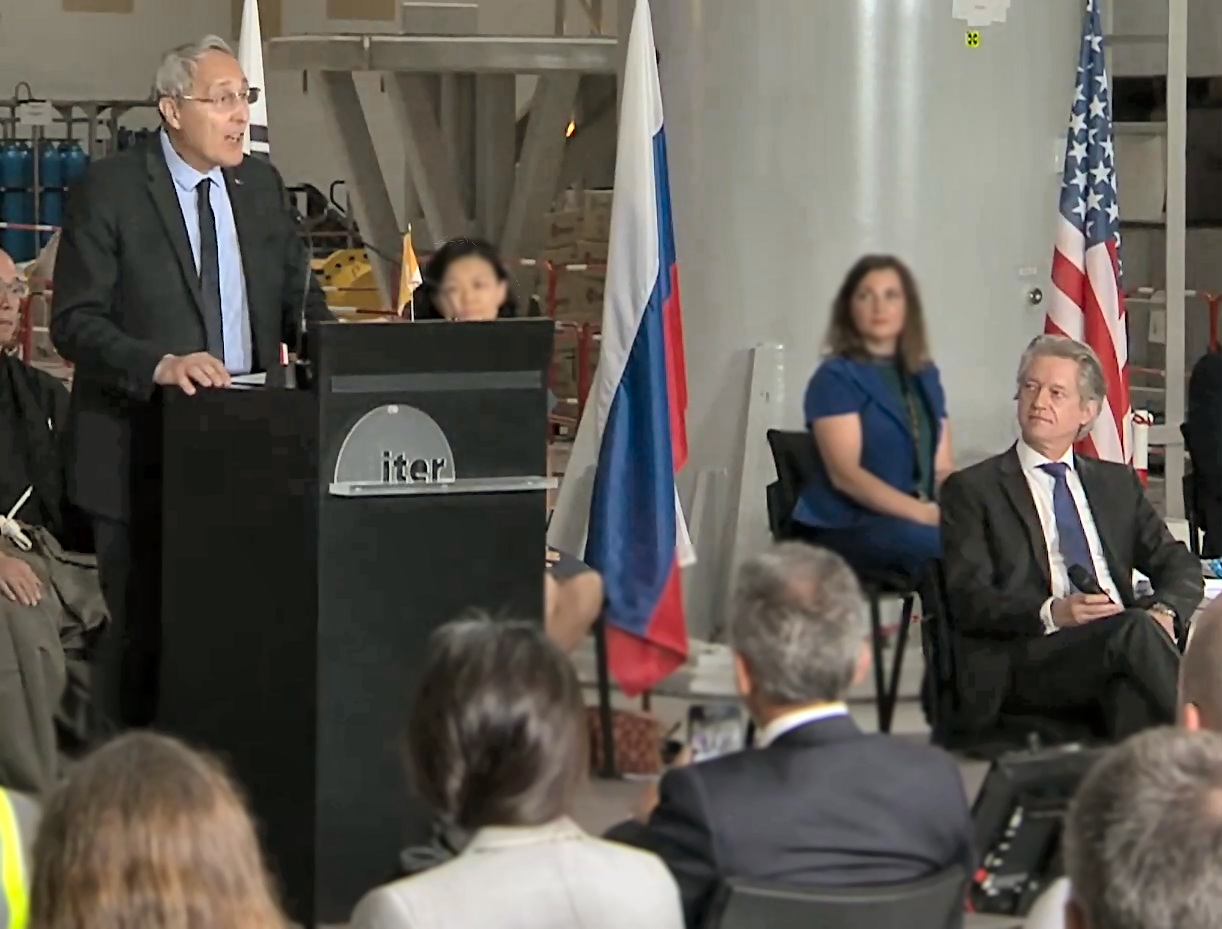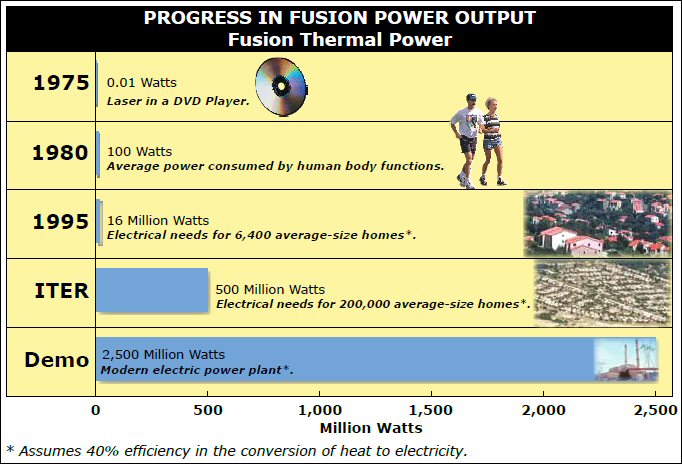CLICK HERE FOR ENGLISH VERSION
Retour à la page principale d’ITER Power Facts
Par Steven B. Krivit
Traduction par Th.P.
Nov. 22, 2020
Cet article décrit une correspondance fascinante que j’ai eue pendant trois jours en octobre 2020 avec le Dr Tim Luce, Scientifique en Chef de ITER-Organization. J’ai lancé la conversation en réponse à une déclaration qu’il a faite sur la puissance thermique que le réacteur ITER est censé produire.
Un peu d’informations générales aideront les nouveaux lecteurs sur mon enquête ITER, mais si vous la connaissez déjà, vous pouvez passer au sous-titre LE FINANCEMENT.
JET
Le 31 octobre 1997, le réacteur Joint European Torus (JET) de Culham, au Royaume-Uni, a produit des particules de fusion avec un niveau record de puissance thermique pendant deux secondes. Au maximum de l’expérience, les réactions de fusion ont produit une l’énergie thermique 16 millions de watts. C’est la ligne bleue dans le graphique ci-dessous. Le graphique et le texte proviennent d’une présentation de diapositives de Nick Holloway, porte-parole de l’Autorité britannique de l’Energie Atomique.
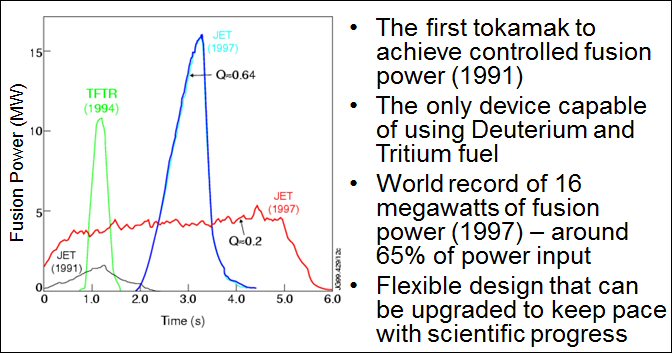
JET’s record-setting 1997 fusion result, shown in Nick Holloway’s slide presentation.
En 2014, j’avais découvert que de nombreux scientifiques de la fusion et leurs promoteurs avaient fait des déclarations inexactes sur les résultats de cette expérience. Ils l’avaient fait depuis au moins 1974. Il était devenu courant de dire que JET avait produit de l’énergie thermique à partir de la fusion au niveau de 16 MW à partir d’une puissance injectée totale de seulement 24 MW. Voici un exemple tiré du site Web de l’organisation ITER avant que je ne leur conseille de le corriger. Voici un exemple tiré d’une publication du Parlement Européen avant que je leur dise que des experts en fusion les avaient induits en erreur.
Moi-même et, semble-t-il, toutes les personnes non-scientifique de la fusion, y compris Holloway, nous pensions que JET avait produit son record mondial de 16 MW à partir d’une puissance d’entrée totale du réacteur de seulement 24 mégawatts d’électricité, produisant ainsi 65% de la puissance consommée par l’ensemble du réacteur.
Quand j’ai réalisé en 2014 que la valeur d’entrée de 24 MW n’était pas la valeur correcte consommé par le réacteur, j’ai cherché sur Internet la valeur réelle. Autant que je sache, il n’existait sur aucune page Web publique. J’ai donc envoyé un e-mail à Holloway et lui ai demandé des informations. Il ne savait pas non plus, mais il a demandé à son collègue Chris Warrick. Deux jours plus tard, Holloway est revenu vers moi. Ils ont dit que JET avait besoin d’une puissance électrique d’entrée de 700 MW, et non de 24 MW. Cela signifiait que le record mondial de 16 MW de puissance de JET n’était pas de 65% du taux d’entrée d’énergie, mais seulement de 1%.
ITER
Peu de temps après avoir reçu ces informations révélatrices, j’ai commencé à examiner les affirmations auprès du public que les scientifiques de la fusion et leurs promoteurs faisaient à propos du projet de réacteur ITER, plus récent et plus grand. Je pouvais voir qu’ils utilisaient le même langage ambigu qu’ils avaient utilisé avec JET pendant des années. Je savais que le taux de puissance thermique attendu de 500 MW était exact. Je savais que le niveau de puissance d’entrée revendiqué de seulement 50 MW – pour l’ensemble du réacteur – était faux. Mais l’organisation ITER n’a pas publié clairement la valeur d’entrée correcte sur son site Web. Je n’ai pas eu le temps de rechercher la puissance d’entrée correcte jusqu’à la fin de 2016.
En décembre 2016, j’ai envoyé un e-mail à Bernard Bigot, le Directeur-Général de l’organisation ITER, et lui ai demandé le niveau de puissance d’entrée réél pour l’ensemble du réacteur. Il n’a pas répondu.
J’ai commencé une conversation par e-mail avec Laban Coblentz, le porte-parole de l’organisation. Coblentz m’a dit qu’il serait trop difficile de déterminer une valeur simple et unique pour la puissance d’entrée requise pour le réacteur.
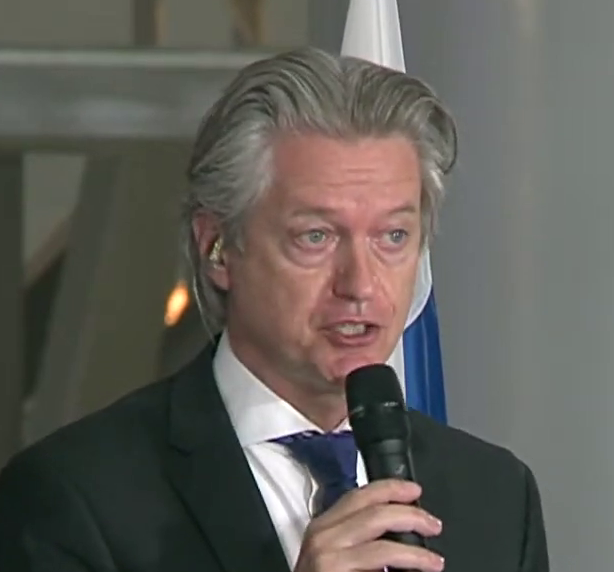
Laban Coblentz, porte-parole de l’organisation ITER
Ce n’est que récemment, avec le recul, que j’ai réalisé que, enfouie profondément dans ses e-mails, l’information était là. Mais c’était pour moi, à l’époque, du jargon technique. J’aurais dû évaluer la valeur de la puissance d’entrée à partir de deux ensembles principaux consommation de puissance que Coblentz m’avait donnés pour le réacteur. Le premier poste de consommation d’énergie consommera de l’énergie électrique à un taux de 150 MW, et l’autre sera de 120 MW. Coblentz savait donc que la puissance d’entrée requise pour ITER – pour obtenir sa production thermique de 500 MW – était de 270 MW d’électricité.
Si nous supposons que Coblentz connaissait la perte bien connue associée à la conversion de l’énergie thermique en énergie électrique, alors il savait que la puissance nette attendue du réacteur ITER était équivalente à zéro watts. Néanmoins, depuis janvier 2017, Coblentz continue de publier sur le site Web de l’organisation des communiqués de presse et des pages Web qui indiquent à tort ou créent la fausse impression que la puissance globale du réacteur ITER devrait être dix fois supérieure à celle du réacteur et que la conception du réacteur ITER est équivalent à celui d’une petite centrale électrique commerciale.
300 MW
La première personne à m’avoir donné une consommation de puissance d’entrée claire et concise selon la conception du réacteur ITER – 300 MW – fut Daniel Jassby, un physicien des plasmas à la retraite du Laboratoire de Physique des Plasmas de Princeton. C’était à l’été 2017. Il a également été la première personne à m’expliquer clairement comment le réacteur ITER est conçu en détaillant les différents types d’alimentation électrique. Peu de temps après, j’ai été en contact deux autres personnes qui m’ont donné indépendamment des chiffres du même ordre. (Toutes mes sources sont répertoriées ici.)
440 MW
Mais s’il y a une personne dans ITER-Organisation qui connaît la puissance électrique d’entrée que l’ensemble du réacteur est censé consommer, c’est Ivone Benfatto. Il est à la tête de la division Génie Electrique de l’organisation ITER.

Ivone Benfatto
J’ai un exemplaire de son article scientifique « Power Converters for ITER » depuis de nombreuses années, mais je ne l’avais pas bien compris jusqu’à récemment. Une des choses délicates à comprendre est que, bien que le réacteur ait besoin de trois catégories de puissance d’entrée, seules deux d’entre elles sont effectivement consommées. Dans le graphique et la légende ci-dessous, Benfatto appelle l’une d’elles «puissance active» et les autres «systèmes auxiliaires du réacteur». La troisième catégorie est appelée «puissance réactive». Cette dernière énergie est stockée, renvoyée et non consommée. Il est principalement utilisé par le système d’aimants supraconducteurs.
J’ai compris dès le début de mes conversations avec Coblentz et Jassby que, lorsque le réacteur ITER commence son expérience de 500 secondes, un bref pic est attendu pendant environ 20 secondes. Lorsqu’il s’arrête, une courte période d’oscillation de la puissance est également attendue. Coblentz a appelé les «effets de fin de tir».
Benfatto a exécuté une simulation informatique des charges de puissance attendues pendant l’expérience. Pendant la majeure partie de l’expérience de 500 secondes, la demande de puissance active devrait plafonner à un niveau d’environ 320 MW. J’ai mis en évidence en jaune ci-dessous cette partie de la forme d’onde de puissance. Les systèmes auxiliaires du réacteur utiliseront 120 MW supplémentaires, ce qui portera la consommation électrique totale d’entrée à 440 MW. Je ne sais pas pourquoi la valeur globale de la puissance d’entrée fournie par Benfatto est supérieure à la valeur de 300 MW que d’autres sources m’ont fournie, mais j’ai utilisé la valeur 300 MW dans mes rapports pour être prudent. J’ai envoyé plusieurs e-mails à Benfatto, mais il n’a jamais répondu.
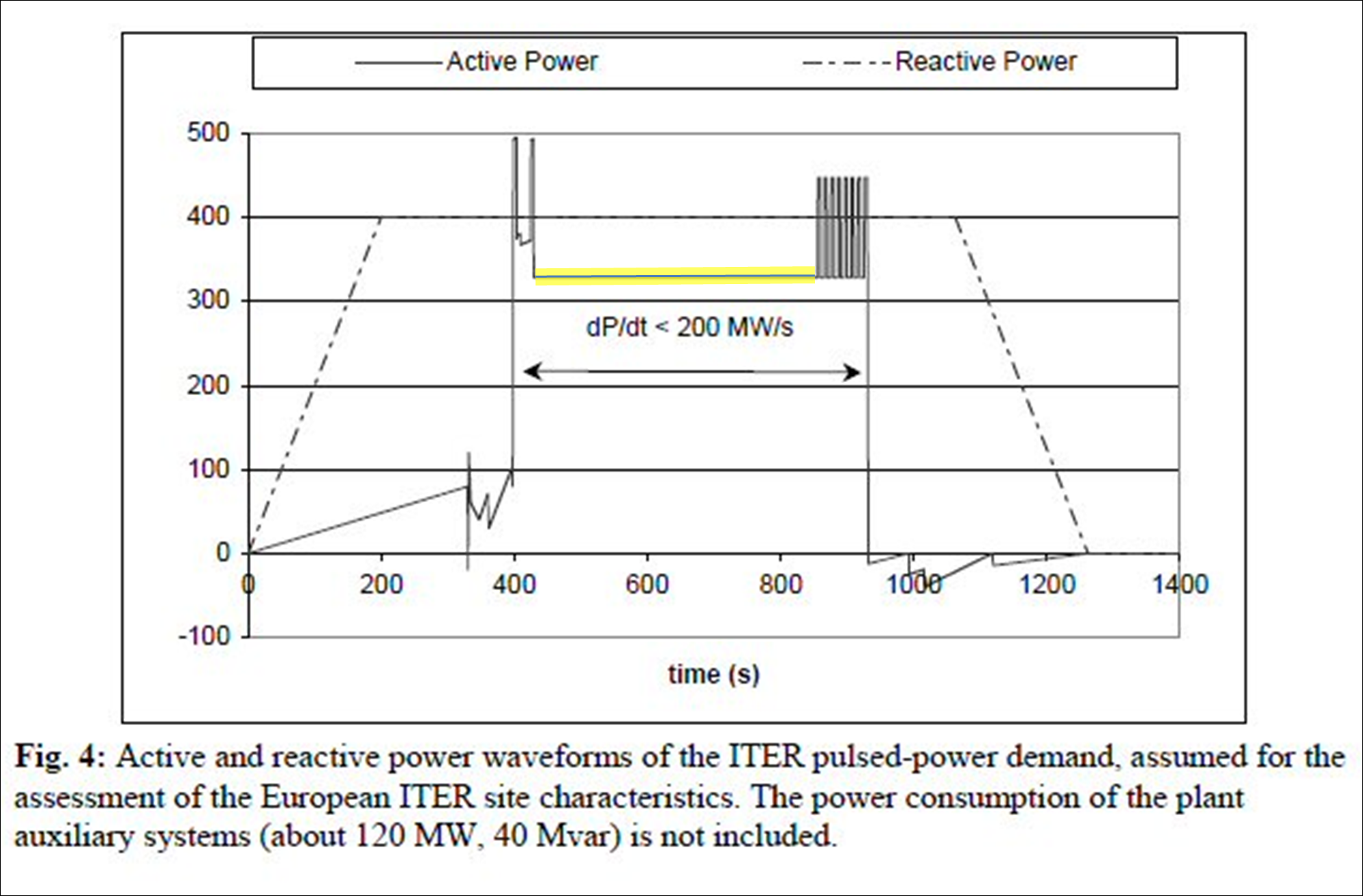
Benfatto computer simulation of ITER reactor active and reactive power drains
PUISSANCE NETTE NULLE
J’ai passé beaucoup de temps à discuter avec des experts de la fusion de la puissance thermique qui pourrait être récupérée à partir d’une conception de réacteur comme ITER. Le consensus, en supposant une charge de puissance d’entrée de seulement 300 MW (au lieu de 440 MW) et des gains et pertes relativement optimistes, est que la conception d’ITER, si sa puissance thermique était convertie en électricité, produirait environ zéro Watts. (Cliquez ici pour un aperçu complet des puissances en jeu.)
LE FINANCEMENT
Voici la prochaine information de fond sur l’histoire de Tim Luce: En 2013, le Congrès américain, après avoir constaté des retards dans le calendrier de construction d’ITER, a commencé à se demander s’il devait continuer à dépenser l’argent public pour ITER. Le Congrès a demandé à Ernest Moniz, le Secrétaire à l’Énergie, d’examiner ce point. Trois ans plus tard, en 2016, Moniz a recommandé que les États-Unis continuent à être un partenaire pendant encore deux ans, jusqu’à l’exercice 2018. Mais Moniz a indiqué que la participation américaine devrait être réévaluée à ce moment-là. Le bureau du secrétaire a demandé l’aide de l’Académie Nationales des Sciences-US. À son tour, l’académie a formé un comité formé de spécialistes de la fusion pour réfléchir à la question. Le comité a recommandé la poursuite de la participation américaine au projet international.
LUCE
Avant la fin de l’examen du comité de l’Académie National des Sciences, il a dirigé plusieurs réunions sur le sujet ITER. Le 1er février 2018, il a tenu sa quatrième réunion. Il s’est déroulé au siège d’ITER en France. La réunion a débuté par un discours de bienvenue de Bernard Bigot. Après cela, des membres de haut-niveau de la communauté européenne de la fusion ont fait des présentations. Dans l’après-midi, Luce a fait sa présentation.
Luce a déclaré que la conception du réacteur ITER représente la production d’énergie minimale nécessaire pour une centrale à fusion commerciale.
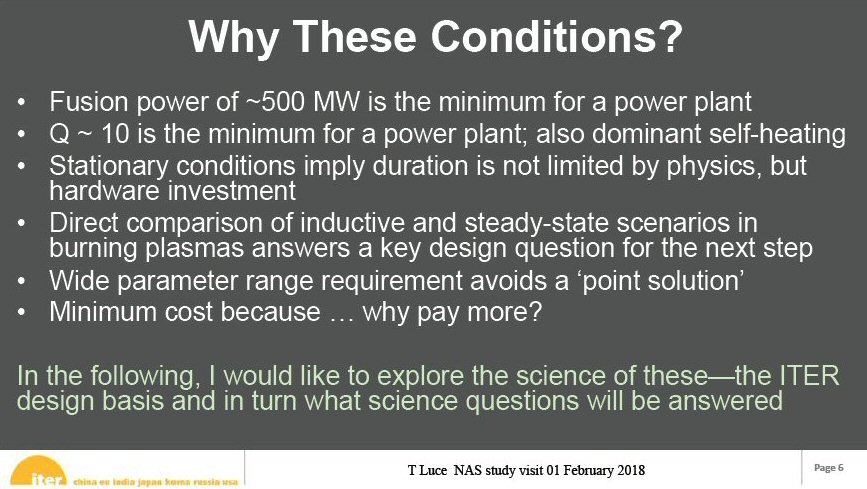
La seule façon dont le réacteur ITER, conçu pour une puissance thermique d’environ 500 MW, pourrait être le «minimum pour une centrale électrique» dans le cas où elle pourrait se passer des 300 MW de puissance pour fonctionner. J’ai envoyé un courriel à Luce et lui ai dit qu’un réacteur à fusion commercial conçu avec les paramètres d’ITER ne pourrait pas produire un watt d’électricité.
Luce n’était pas d’accord et a répondu que la production thermique d’ITER, si elle était convertie en électricité, serait de 100 MW, assez pour une petite centrale à fusion:
Mon hypothèse est que «l’échelle de la centrale électrique» est> 100 MW de production d’électricité. Une puissance de fusion de 500 MW avec un rendement d’équilibre de la centrale de 0,2 (pas économiquement viable, mais le minimum) serait de 100 MW électriques.
Je lui ai montré mon analyse du bilan de puissance selon la conception du réacteur ITER. Luce a soutenu que les valeurs de puissance dans mon analyse comprenaient quelque chose appelé puissance de recirculation. Je lui ai dit que mes valeurs n’incluaient pas la puissance de recirculation. Ensuite, il a fait valoir que mes valeurs incluaient la consommation d’énergie temporaire (réactive) pour le système magnétique. Je lui ai dit que non. Enfin, dans l’e-mail n ° 17, Luce m’a dit que le niveau de puissance électrique nécessaire pour faire fonctionner ITER n’était pas de 300 MW mais quelque part entre 100 MW et 150 MW et que, par conséquent, le réacteur produirait une puissance électrique de sortie nette équivalente
à 100 MW d’électricité.
Je me suis alors rendu compte que Luce n’avait aucune idée de la puissance électrique dont ITER aurait besoin pour fonctionner. Je lui ai envoyé mes sources. Un jour plus tard, après avoir vu mes sources, Luce m’a répondu et m’a dit que son calcul initial était une «estimation peu précise». Il est revenu en arrière et a souligné que le projet ITER n’était pas conçu pour produire de façon nette de l’électricité.
Je lui ai répondu et lui ai dit que tout le monde sait qu’ITER n’est pas conçu pour produire finalement de l’électricité. Le problème, lui ai-je indiqué, était qu’il avait dit à tout le monde lors de la réunion de l’ Académie Nationale des Sciences, ainsi qu’au gouvenrment US, que la conception d’ITER démontrerait les performances minimales nécessaires pour une centrale électrique en état de marche. La seule façon dont cela pourrait être vrai était si Luce sous-déclarait la puissance d’entrée requise.
J’ai demandé à Luce s’il contestait la valeur d’entrée du réacteur de 300 MW et, dans la négative, s’il retirerait sa déclaration selon laquelle, dans la conception d’ITER, «une puissance de fusion d’environ 500 MW est le minimum pour une centrale électrique».
Trois semaines plus tard, Luce a répondu. Il a continué à défendre sa position.
«À un public scientifique», a écrit Luce, «j’ai fait valoir que c’était la taille minimale pour être crédible, car la démonstration provenait d’un plasma à l’échelle d’une centrale électrique.»
Oui, certainement, un plasma de 500 mégawatts lui-même est à «l’échelle d’une centrale électrique». Mais si la puissance d’entrée requise pour créer ce plasma est soustraite, vous obtenez une production nette de zéro Watts – pas tout à fait «le minimum pour une centrale électrique».
Il a soutenu que je ne comprenais pas le sujet parce que j’avais mal utilisé certains termes. Ensuite, il a écrit un long paragraphe soutenant que les sources que j’avais citées pour la valeur de 300 MW – y compris Laban Coblentz, le porte-parole de l’organisation ITER; Steve Cowley, directeur du Princeton Plasma Physics Laboratory et ancien directeur de la United Kingdom Atomic Energy Authority; et Hartmut Zohm, chef de la division de développement de scénarios de tokamak au Max-Planck-Institute of Plasma Physics – n’étaient pas crédibles.
La seule chose que Luce n’a pas contestée en fait était la valeur de 300 MW que m’avaient donné ces sources indépendantes. Luce a terminé son e-mail en me demandant de ne publier aucun extrait de notre conversation.
La Politique de l’Autruche
Le fait que le scientifique en chef du projet scientifique le plus grand et le plus cher de la planète ne semble pas familier avec un fait aussi crucial est la première partie de cette histoire. La deuxième partie est que chacun des spécialistes de la fusion qui était dans la pièce a soit accepté la déclaration fausse et exagérée de Luce, soit ne s’est pas rendu compte que c’était faux.
Une Tendance Générale
Voici la troisième partie de l’histoire. J’étais curieux de connaître les autres mentions de puissance que Luce aurait pu faire publiquement. Revendiquer une taux puissance d’entrée erronée et sous-estimée équivaut en fait à revendiquer un taux de puissance de sortie faussement plus élevé. L’un ou l’autre des mensonges entraîne une exagération de la production nette.
J’ai appris que, lorsque Luce s’est entretenu avec d’autres journalistes, il ne s’est pas contenté de leur dire, comme il me l’a dit, que la puissance d’entrée requise d’ITER était comprise entre 100 MW et 150 MW. Il leur a dit qu’ITER aurait besoin d’une source de puissance de seulement 50 MW pour fonctionner.
Dans un article de 2018 dans La Repubblica, Luce a déclaré au journaliste: «Nous prévoyons de produire 500 mégawatts avec 50 mégawatts de consommation.
Il jouait le même tour que tous les autres qui avaient fait de fausses déclarations sur ITER. Il a donné au journaliste la valeur de 50 MW, qui n’est que la valeur de puissance de chauffage injectée dans le plasma du réacteur. Luce a laissé entendre que cette valeur de 50 mégawatts était la puissance dont l’ensemble du réacteur aurait besoin pour fonctionner. Mais la valeur de 50 mégawatts ne représente au plus que 16% de la puissance dont l’ensemble du réacteur a réellement besoin pour fonctionner pendant 6 minutes,
J’étais perplexe. Pourquoi un scientifique occupant une position aussi importante, représentant le projet scientifique le plus cher au monde, dirait-il à un journaliste qu’ITER ne consommerait que 50 mégawatts au lieu de 300 mégawatts?
Même si Luce croyait à tort qu’ITER aurait besoin d’une puissance d’entrée de seulement 100 mégawatts pour fonctionner, pourquoi a-t-il dit au journaliste qu’il ne lui faudrait que 50 MW? J’ai regardé pour voir si ces déclarations étaient exceptionnelles ou la norme pour Luce.
J’ai trouvé un article dans le Guardian de 2019. Après avoir parlé avec Luce, le journaliste a transmis aux lecteurs du Guardian le même affirmation inexacte, à savoir qu’ITER est conçu pour produire 10 fois plus d’énergie qu’il en a besoin pour fonctionner.
J’ai trouvé un article dans Le Parisien dans lequel Luce disait aux journalistes que l’objectif du réacteur était de produire 10 fois plus d’énergie qu’il n’en consomme, une puissance de 500 mégawatts pour une entrée de 50 mégawatts.
Luce a été interviewé en août de cette année par Intellect Interviews . Il a dit la même chose: «Nous sortons 10 fois plus d’énergie que ce que nous mettons.» Voici le point clé de toutes ses communications publiques: Luce n’a fait aucun effort pour préciser la valeur de 50 MW comme la puissance thermique injectée pour chauffer le plasma. Au lieu de cela, il a clairement et systématiquement laissé entendre que le réacteur global n’aurait besoin que de 50 MW pour fonctionner.

Tim Luce, scientifique en chef de l’organisation ITER
J’ai également trouvé un article de septembre 2020 dans lequel Tim Luce et Bernard Bigot ont été interviewés par le magazine Nature et Luce a déclaré qu’ITER, sans préciser les valeurs des puissances thermiques d’entrée et de sortie, était conçu pour produire 500 mégawatts de puissance, dix fois la puissance d’entrée.
Pourquoi un scientifique intelligent et compétent continuerait-il de dire aux journalistes et au public, et peut-être aux représentants du gouvernement, qu’ITER est conçu pour produire 500 mégawatts d’énergie à partir de seulement 50 mégawatts de puissance d’entrée sans faire aucun effort pour informer les gens sur ce que ces chiffres signifient vraiment? J’ai envisagé d’écrire un autre e-mail et de lui demander.
Mais j’ai compris pourquoi il avait donné des informations trompeuses aux médias d’information, au public et au gouvernement sur ce qu’ITER est censé faire: c’est précisément sa fonction chez ITER.









